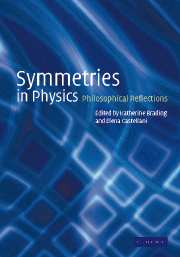Book contents
- Frontmatter
- Contents
- List of contributors
- Preface
- Copyright acknowledgements
- 1 Introduction
- Part I Continuous symmetries
- 2 Classic texts: extracts from Weyl and Wigner
- 3 On continuous symmetries and the foundations of modern physics
- 4 The philosophical roots of the gauge principle: Weyl and transcendental phenomenological idealism
- 5 Symmetries and Noether's theorems
- 6 General covariance, gauge theories, and the Kretschmann objection
- 7 The interpretation of gauge symmetry
- 8 Tracking down gauge: an ode to the constrained Hamiltonian formalism
- 9 Time-dependent symmetries: the link between gauge symmetries and indeterminism
- 10 A fourth way to the Aharonov–Bohm effect
- Part II Discrete symmetries
- Part III Symmetry breaking
- Part IV General interpretative issues
- Index
10 - A fourth way to the Aharonov–Bohm effect
Published online by Cambridge University Press: 08 October 2009
- Frontmatter
- Contents
- List of contributors
- Preface
- Copyright acknowledgements
- 1 Introduction
- Part I Continuous symmetries
- 2 Classic texts: extracts from Weyl and Wigner
- 3 On continuous symmetries and the foundations of modern physics
- 4 The philosophical roots of the gauge principle: Weyl and transcendental phenomenological idealism
- 5 Symmetries and Noether's theorems
- 6 General covariance, gauge theories, and the Kretschmann objection
- 7 The interpretation of gauge symmetry
- 8 Tracking down gauge: an ode to the constrained Hamiltonian formalism
- 9 Time-dependent symmetries: the link between gauge symmetries and indeterminism
- 10 A fourth way to the Aharonov–Bohm effect
- Part II Discrete symmetries
- Part III Symmetry breaking
- Part IV General interpretative issues
- Index
Summary
Three attempts for an explanation of the Aharonov–Bohm effect
The Aharonov–Bohm (A–B) effect is an effect one finds in every quantum field theory book and this is so for a very good reason. The prediction and subsequent experimental verification of the effect have been crucial cornerstones in the history of physics because they suggested that the gauge potential, also known as the Aμ field, might be interpreted as a real field, rather than just a mathematical artifact. Hence, ever since its discovery, physicists have taken it for granted that Aμ does represent something at least as tangible as any matter field. However, when one examines these arguments more closely, one realizes that attributing the status of a really existent field to the Aμ field is not as straightforward as was originally thought. But first things first: we begin with an account of the effect itself, and then attempt to give some explanation for it.
The effect
The setting for the A–B effect is very similar to the two-slit experiment, with just one difference: immediately beyond the two slits and in between them is a very fine and long solenoid, ideally infinitely long, producing a magnetic field that is confined entirely within the tube of the solenoid.
- Type
- Chapter
- Information
- Symmetries in PhysicsPhilosophical Reflections, pp. 174 - 200Publisher: Cambridge University PressPrint publication year: 2003
- 6
- Cited by



